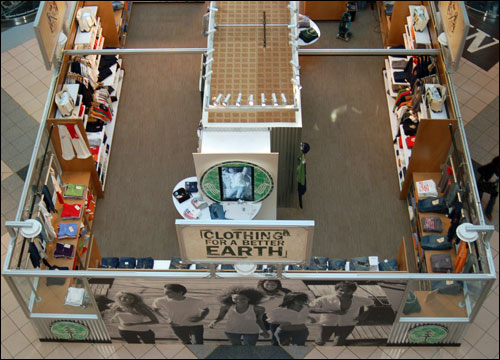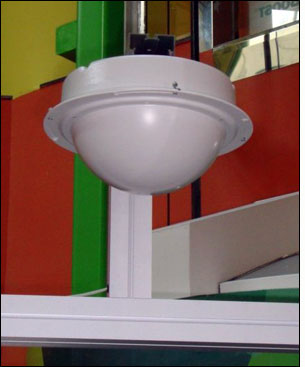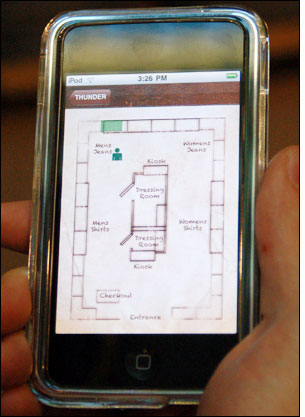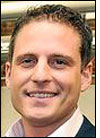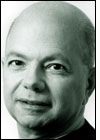Clothing for a Better Earth, a New York retailer specializing in eco-friendly garments, has opened its doors as a showcase for RFID technology, providing customers with the kind of shopping experience—such as tracking purchasing preferences and making recommendations—currently available only on the Internet. The store has a temporary home in Carousel Center, a mall being developed by Destiny USA, in Syracuse, N.Y.
The system is provided by Destiny USA, and the company hopes to offer it to many other new stores opening within the eight-story shopping complex as well. It incorporates two types of RFID technology: active ultra-wideband (UWB) tags and readers provided by Time Domain Corp., known as the Precision Location Ultra Wideband System (PLUS), and an ultrahigh-frequency (UHF) RFID system with Avery Dennison passive tags and Impinj interrogators. The Destiny USA Technology Platform ties these two systems together using a software platform provided by New York software firm Terakeet.
With its RFID deployment, Clothing for a Better Earth is also serving as a showcase for what the technology can do, and has invited other retailers to come take a look and consider how they could use RFID within their own space. The goal, says Pat Danial, Terakeet’s chief technology officer and co-founder, is to provide the system at numerous stores within the Carousel Center, part of a 1.3 million-square-foot mall complex under construction.
Clothing for a Better Earth, a new company that offers apparel made from natural, organic fibers, opened its first branch at a temporary 1,100-square-foot location in an open-air section of the mall, while a new area is being constructed, explains Frank Fiumano, the retailer’s general manager. The store opened last year on so-called Black Friday—the day after Thanksgiving. With RFID, shoppers can track their own purchases, as well as learn about other products they might consider buying, and the store can gain data regarding shopper behavior, while also tracking its own inventory.
One part of the system, provided by Time Domain, utilizes active UWB technology. Upon entering the store, customers are offered an iPod Touch with an active Time Domain RFID tag attached to its case. The sales staff explain the system, and also describe the organic products sold in the store. They then input two basic pieces of information into the iPod—the visitor’s gender and approximate age—and hand the device to the customer, who can then simply carry the phone without providing any further information. In that case, the system recognizes when the shopper approaches a specific location of the store, and provides age- and gender-specific content to the phone.
For a more personal experience, however, the patron can enter additional information into the iPod Touch, such as an e-mail address, phone number and purchasing preferences—clothing styles or sizes, for instance. Such data is then linked to the ID number on the phone’s tag, and is uploaded via Wi-Fi to Terakeet’s platform software, on the store’s server. The customer’s movements through the shop are also stored with her account information, which she can later access by logging into the store’s Web site, thereby allowing her to see where she was, as well as which items she might have been looking at. While logged in, she could, for example, place an order for other sizes or colors that might not have been in the store.
As the shopper moves through the 1,100-square-foot space, the tag transmits a UWB signal (3.1 to 10.6 GHz) encoded with the tag’s unique ID number. Eight Time Domain antennas hanging above the sales floor receive the signals, and Time Domain software, using triangulation, calculates the shopper’s location within approximately 1 foot, explains Greg Clawson, Time Domain’s senior VP of sales and marketing. The location information is then sent via a Wi-Fi connection to the iPod, which displays a map of the store along with an icon indicating where that individual is located. As she approaches specific areas within the store, video monitors mounted in those sections display information regarding the products, tailoring that information to the shopper’s inputted purchasing preferences (such as denim jackets or pants, for instance).
The other part of the RFID solution is the UHF Gen 2 tagging of products. Each item bears an Avery Dennison UHF tag, attached at the factory at which the garment was manufactured, either in the form of an adhesive label placed directly on the item, or a paper hangtag attached via a string. When an item is taken to the changing room, Impinj reader antennas capture its tag’s unique ID number, after which a video monitor in the room displays information about other products that might complement that garment.
Terakeet software links together data from the two RFID systems, thereby enabling Clothing for a Better Earth to know which customer is trying on which item. Finally, when a shopper is ready to make a purchase, she goes to a sales terminal, where an Impinj RFID interrogator captures the tag ID number of each item and cross-references that ID number in the store’s point-of-sale system, as if the ID number were a bar-coded SKU. The item is then rung up while it is also removed from the inventory list in the back-end software. In addition, Time Domain locates the shopper’s position as being at the point of sale, and links the purchases being made at that time with her account information, storing that data to create a purchasing history that could be referenced during future shopping visits. “All these systems need to work together,” Danial says.
Upon leaving the store, the shopper hands the Touch iPod back to an employee, who clears the data on the device, thereby making it ready for the next customer, while information about the shopper’s visit is stored in the Web-based server. At home, that individual can visit Clothing for a Better Earth’s Web site, sign into her account and learn more about the products she carried into the changing room, whether or not she purchased those items.
Shoppers have been enthusiastic about the system, Fiumano says, and many have chosen to create an account to help them—and the store—track their interests and purchases. “Most of our customers are between 18 and 25,” he explains, “and they are very comfortable with technology.” He adds that all ages, however, come into the store, often simply out of curiosity, because the signage describing organic products and the technology’s video monitors and antennas are clearly visible from multiple floors in the atrium. “It definitely has a wow/coolness factor,” he says, adding that the software is designed to make it easy to make changes to inventory, such as adding or removing content as stock levels change.
The entire system was first conceived by Destiny USA, which approached Terakeet to provide a platform that would allow the use of RFID technology for tracking shoppers, while enabling them to gain additional information regarding the products they shop for. Terakeet then brought Time Domain into the project, to develop the UWB real-time locating system.
This is the first phase of the deployment, Danial says. In the near future, the store plans to open an automatic checkout kiosk that will enable customers to purchase items without queuing up at a sales counter. The reader would simply capture the ID number on each item’s tag, and access credit card information that customers would input into their account on the store’s Web site, or a patron could simply scan her credit card, and that transaction would be complete. Danial says he would also like to see the passive UHF EPC Gen 2 tags be used for tracking inventory as it leaves the manufacturing site, and as it enters the store. What’s more, he would like to set up a system in which products could be tracked at any point within the store—currently, this only occurs when they pass near an RFID reader.
Initially, Terakeet built a prototype that it tested in a lab setting, before setting up the system for Clothing for a Better Earth. Danial hopes to see other retailers come to the store to test the system. “We wanted to set up a playground of sorts,” he says. “We wanted to create a place rich with technology, so brands could try this out.”
Terakeet and Time Domain decline to reveal the system’s cost, adding that each deployment will vary according to the number of iPods, video monitors, and RFID readers, antennas and tags used. Clothing for a Better Earth plans to install the system at its permanent store when the time comes to move in. It also intends to open additional shops elsewhere that will also incorporate the technology, though details regarding that development have yet to be determined.

